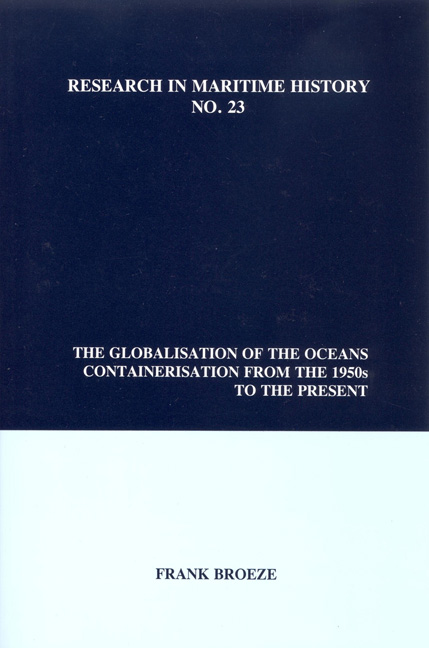Book contents
- Frontmatter
- Table of Contents
- List of Figures
- List of Tables
- Abbreviations
- Acknowledgments
- Preface
- Introduction
- Chapter 1 A Concept and its Realisation
- Chapter 2 The First Revolution
- Chapter 3 The 1970s: Conquering the World
- Chapter 4 The 1980s: Crisis and the Second Revolution
- Chapter 5 The 1990s: Globalisation
- Chapter 6 Ports, Port Systems and Liner Networks
- Chapter 7 Maritime Labour
- Chapter 8 Culture, the Environment and Recycling
- Conclusion
- Select Bibliography
Chapter 4 - The 1980s: Crisis and the Second Revolution
- Frontmatter
- Table of Contents
- List of Figures
- List of Tables
- Abbreviations
- Acknowledgments
- Preface
- Introduction
- Chapter 1 A Concept and its Realisation
- Chapter 2 The First Revolution
- Chapter 3 The 1970s: Conquering the World
- Chapter 4 The 1980s: Crisis and the Second Revolution
- Chapter 5 The 1990s: Globalisation
- Chapter 6 Ports, Port Systems and Liner Networks
- Chapter 7 Maritime Labour
- Chapter 8 Culture, the Environment and Recycling
- Conclusion
- Select Bibliography
Summary
Gone was the glamorous growth that had characterised the industry for much of the 1970s; probably never to return again to an industry that had finally come of age.
Containerisation had made extraordinary progress during the 1970s. In contrast, market conditions throughout most of the 1980s were anything but favourable; in consequence, “fierce competition between carriers was sustained.” The decade began with a rapidly-escalating crisis which reached its deepest point by 1983 as the impact of a structural tonnage glut was exacerbated by a severe global trade recession. Container shipping, with only a few exceptions, was beginning to look as unhealthy as the long-suffering bulk sector. A brief recovery was followed by a second recession in 1985-1986 when trade with the Middle East, which had already slowed down since the Iranian revolution and the outbreak of the Gulf War in 1980 collapsed due to a huge fall in the price of crude oil from c. US $40 to US $10 and even lower per barrel. As well, the sharp devaluation of the US dollar, in which most freight was paid, after the Plaza agreement of 1985 and the stock market crash of October 1987 had a negative effect. NOL later declared that the years 1984-1989 were “probably the toughest” for the company, and that sentiment was echoed by many of its colleagues.
Although some powerful newcomers emerged during the decade, the 1980s were also marked by the demise, takeover or withdrawal of a number of traditional companies. Rationalisation and cooperation of various kinds between companies helped to reduce both cost levels and the surplus of tonnage, and across the board rates showed modest improvements. Nevertheless, by 1990 the industry remained in turmoil, and its instability was accentuated by a number of contradictory trends and fuelled rather than calmed by the apparent return to profitability.
Yet despite the gloom which dominated so much of the decade, container shipping continued to grow at a remarkable rate and exhibited evidence of such significant structural changes that there may well be said to have been a second revolution. Between 1980 and 1990, the total capacity of the world's container fleet increased from 1,200,000 to 3,200,000 TEUs, a growth rate of 167 percent or about thirteen percent per annum, compared with the roughly twenty-percent expansion of the previous decade.
- Type
- Chapter
- Information
- The Globalisation of the OceansContainerisation from the 1950s to the Present, pp. 79 - 114Publisher: Liverpool University PressPrint publication year: 2000



